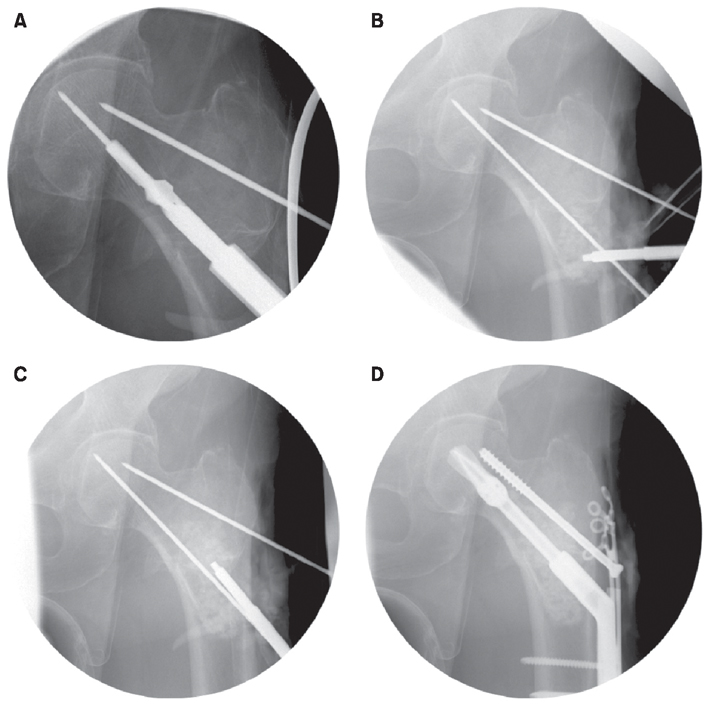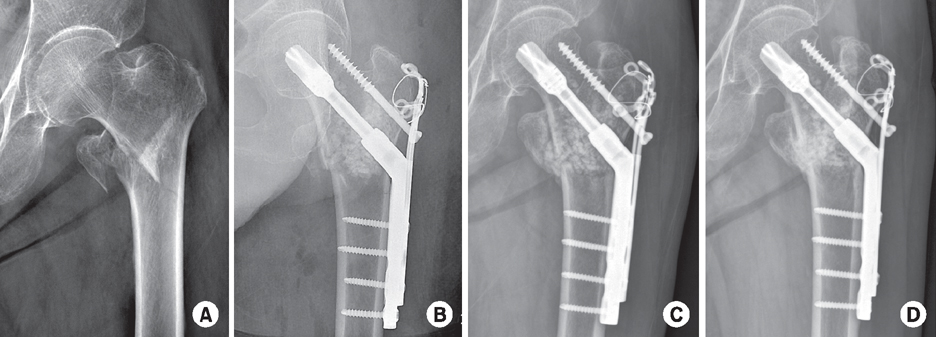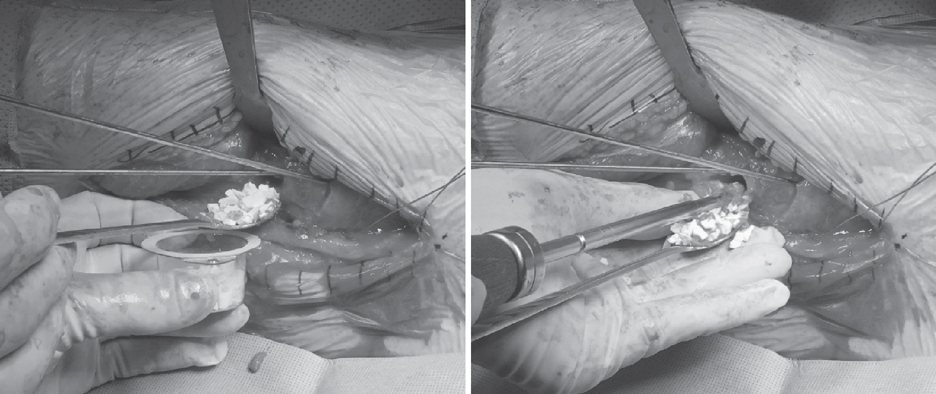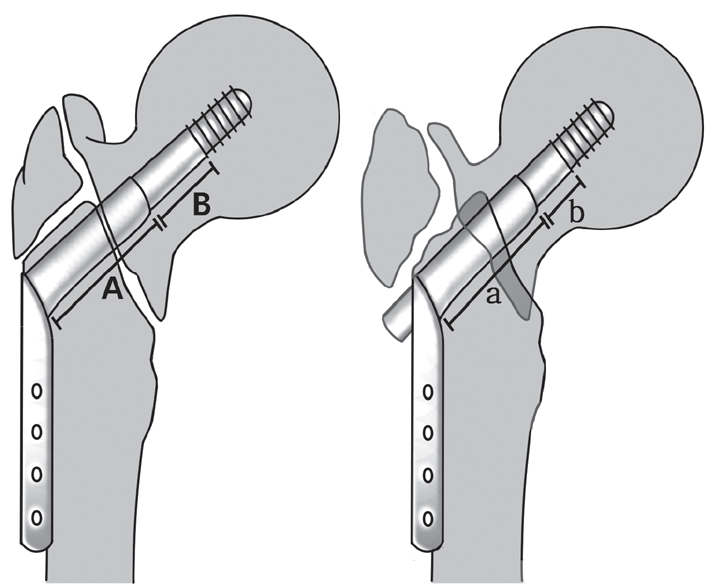Articles
- Page Path
- HOME > J Musculoskelet Trauma > Volume 29(4); 2016 > Article
-
Original Article
- The Role of Beta-Tricalcium Phosphate Graft in the Dynamic Hip Screw Fixation of Unstable Intertrochanter Fracture
- Chul-Ho Kim, M.D., Ji Wan Kim, M.D., Ph.D., Eic Ju Lim, M.D., Jae Suk Chang, M.D., Ph.D.
-
Journal of the Korean Fracture Society 2016;29(4):250-257.
DOI: https://doi.org/10.12671/jkfs.2016.29.4.250
Published online: October 20, 2016
Department of Orthopedic Surgery, Asan Medical Center, Ulsan University College of Medicine, Seoul, Inje University College of Medicine, Busan, Korea.
*Department of Orthopedic Surgery, Inje University Haeundae Paik Hospital, Inje University College of Medicine, Busan, Korea.
- Address reprint requests to: Jae Suk Chang, M.D., Ph.D. Department of Orthopedic Surgery, Asan Medical Center, Ulsan University College of Medicine, 88 Olympic-ro 43-gil, Songpa-gu, Seoul 05505, Korea. Tel: 82-2-3010-3525·Fax: 82-2-488-7877, jschang@amc.seoul.kr
Copyright © 2016 The Korean Fracture Society. All rights reserved.
This is an Open Access article distributed under the terms of the Creative Commons Attribution Non-Commercial License (http://creativecommons.org/licenses/by-nc/4.0) which permits unrestricted non-commercial use, distribution, and reproduction in any medium, provided the original work is properly cited.
- 356 Views
- 3 Download
Abstract
-
Purpose
- The purpose of this study was to introduce our method of stabilizing unstable intertrochanteric fractures by using the dynamic hip screw (DHS) with a beta-tricalcium phosphate (β-TCP) graft and to compare the outcomes of this procedure with those of the conventional DHS without β-TCP.
-
Materials and Methods
- Patients who underwent surgery by using DHS between March 2002 and January 2016 were retrospectively reviewed for analysis of the outcomes. The inclusion criteria were: 1) age of 60 years and older; 2) low-energy fracture resulting from a fall from no greater than the standing height; 3) multifragmentary pertrochanteric fracture (AO classification 31-A2.2, 2.3); and 4) follow-up of over 3 months. We compared 29 patients (29 hips) who underwent surgery, using DHS without β-TCP, with 29 age-sex matched patients (29 hips) who underwent surgery using DHS with grafted β-TCP granules to empty the trochanter area after reaming. We investigated the fracture union rate, union time, and length of lag screw sliding.
-
Results
- Bone union was achieved in all cases. The mean union time was 7.0 weeks in the β-TCP group and 8 .8 weeks in the non-β-TCP group. The length of lag screw sliding was 3.6 mm in the β-TCP group and 5 .5 mm in the non-β-TCP group. There were no implant failure cases in both groups.
-
Conclusion
- The β-TCP graft for reinforcement DHS acquired satisfactory clinical outcomes for treating unstable intertrochanteric fractures.
- 1. National Health Insurance Service. NHIS statistical information system [Internet], Wonju, National Health Insurance Service. 2015;Oct 19. Available from: http://www.nhis. or.kr/bbs7/boards/B0039/15329
- 2. Jensen JS, Sonne-Holm S, Tøndevold E. Unstable trochanteric fractures. A comparative analysis of four methods of internal fixation. Acta Orthop Scand, 1980;51:949-962.Article
- 3. Koval KJ, Zuckerman JD. Hip fractures: II. Evaluation and treatment of intertrochanteric fractures. J Am Acad Orthop Surg, 1994;2:150-156.Article
- 4. Sambandam SN, Chandrasekharan J, Mounasamy V, Mauffrey C. Intertrochanteric fractures: a review of fixation methods. Eur J Orthop Surg Traumatol, 2016;26:339-353.ArticlePDF
- 5. Laros GS, Moore JF. Complications of fixation in intertrochanteric fractures. Clin Orthop Relat Res, 1974;(101):110-119.
- 6. Stankewich CJ, Swiontkowski MF, Tencer AF, Yetkinler DN, Poser RD. Augmentation of femoral neck fracture fixation with an injectable calcium-phosphate bone mineral cement. J Orthop Res, 1996;14:786-793.Article
- 7. Lu JX, Huang ZW, Tropiano P, et al. Human biological reactions at the interface between bone tissue and polymethylmethacrylate cement. J Mater Sci Mater Med, 2002;13:803-809.ArticlePDF
- 8. Stoffel KK, Leys T, Damen N, Nicholls RL, Kuster MS. A new technique for cement augmentation of the sliding hip screw in proximal femur fractures. Clin Biomech (Bristol, Avon), 2008;23:45-51.Article
- 9. Fillingham Y, Jacobs J. Bone grafts and their substitutes. Bone Joint J, 2016;98-B:1 Suppl A. 6-9.ArticlePDF
- 10. Neamat A, Gawish A, Gamal-Eldeen AM. Beta-tricalcium phosphate promotes cell proliferation, osteogenesis and bone regeneration in intrabony defects in dogs. Arch Oral Biol, 2009;54:1083-1090.
- 11. Baumgaertner MR, Curtin SL, Lindskog DM, Keggi JM. The value of the tip-apex distance in predicting failure of fixation of peritrochanteric fractures of the hip. J Bone Joint Surg, 1995;77:1058-1064.Article
- 12. Kyle RF, Ellis TJ, Templeman DC. Surgical treatment of intertrochanteric hip fractures with associated femoral neck fractures using a sliding hip screw. J Orthop Trauma, 2005;19:1-4.Article
- 13. Doppelt SH. The sliding compression screw: today's best answer for stabilization of intertrochanteric hip fractures. Orthop Clin North Am, 1980;11:507-523.
- 14. Kim KJ, Yang DS, Lee SK, Choy WS, Bae KW. Surgical treatment of femoral unstable intertrochanteric fractures in elderly patients: comparative study between compressive hip screws and additional trochanteric stabilizing plates. J Korean Fract Soc, 2011;24:295-300.Article
- 15. Flores LA, Harrington IJ, Heller M. The stability of intertrochanteric fractures treated with a sliding screw-plate. J Bone Joint Surg Br, 1990;72:37-40.ArticlePDF
- 16. Davis TR, Sher JL, Horsman A, Simpson M, Porter BB, Checketts RG. Intertrochanteric femoral fractures. Mechanical failure after internal fixation. J Bone Joint Surg Br, 1990;72:26-31.ArticlePDF
- 17. Min BW, Lee KJ. Treatment of intertrochanteric fracture: dynamic hip screw. J Korean Fract Soc, 2009;22:51-55.
- 18. Lindner T, Kanakaris NK, Marx B, Cockbain A, Kontakis G, Giannoudis PV. Fractures of the hip and osteoporosis: the role of bone substitutes. J Bone Joint Surg Br, 2009;91:294-303.
- 19. Hofmann-Fliri L, Nicolino TI, Barla J. Cement augmentation of implants: no general cure in osteoporotic fracture treatment. A biomechanical study on non-displaced femoral neck fractures. J Orthop Res, 2016;34:314-319.ArticlePDF
- 20. Yoo JH, Kim TY, Chang JD, Kwak YH, Kwon YS. Factors influencing functional outcomes in united intertrochanteric hip fractures: a negative effect of lag screw sliding. Orthopedics, 2014;37:e1101-e1107.Article
REFERENCES
A 79-year-old female patient. (A) Intraoperative C-arm image shows reaming lag screw. (B) Impaction beta-tricalcium phosphate (β-TCP) granule to lessor trochanter area. (C) Impaction β-TCP granule to greater trochanter area. (D) Post-fixation status.

The Doppelt's method. To measure the extent of sliding, a correction factor was applied. Correction factor=B/b, the extent of sliding=A−a×B/b.

Serial follow-up x-ray of the 70-year-old female patient. (A) Preoperative radiograph shows 31-A2.2 type trochanteric fracture. (B) Immediate postoperative radiograph after surgery using beta-tricalcium phosphate. (C) Postoperative radiograph at the 3-month follow-up. (D) Postoperative radiograph at the 12-month follow-up.

Patients Demographics of the Cohort
Figure & Data
REFERENCES
Citations





Fig. 1
Fig. 2
Fig. 3
Fig. 4
Patients Demographics of the Cohort
| Variable | β-TCP group |
Non-β-TCP group |
p-value |
|---|---|---|---|
| Age (yr) | 74.6±14.2 | 74.6±14.2 | |
| Gender | |||
| Male | 10 (34.5) | 10 (34.5) | |
| Female | 19 (65.5) | 19 (65.5) | |
| BMI (kg/m2) | 21.4±3.4 | 22.6±3.6 | 0.325 |
| BMD (T-score) | −3.6±0.9 | −3.0±1.3 | 0.067 |
| Fracture type | 0.374 | ||
| AO 31–A2.2 | 19 | 15 | |
| AO 31–A2.3 | 10 | 14 |
Values are presented as mean±standard deviation, number (%), or number only. β-TCP: Beta-tricalcium phosphate, BMI: Body mass index, BMD: Bone mineral densitometry.
Comparison between Two Groups of Blade Screw Slippage and Bone Union
| Variable | β-TCP group |
Non-β-TCP group |
p-value |
|---|---|---|---|
| Blade screw slippage (mm) | 3.62±3.46 | 5.50±7.47 | 0.943 |
| Bone union rate | 100 | 100 | |
| Period of bone union (wk) | 7.02±2.14 | 8.80±2.75 | 0.654 |
Values are presented as mean±standard deviation or percent only.
β-TCP: Beta-tricalcium phosphate.
Values are presented as mean±standard deviation, number (%), or number only. β-TCP: Beta-tricalcium phosphate, BMI: Body mass index, BMD: Bone mineral densitometry.
Values are presented as mean±standard deviation or percent only. β-TCP: Beta-tricalcium phosphate.

 E-submission
E-submission KOTA
KOTA TOTA
TOTA TOTS
TOTS

 Cite
Cite

